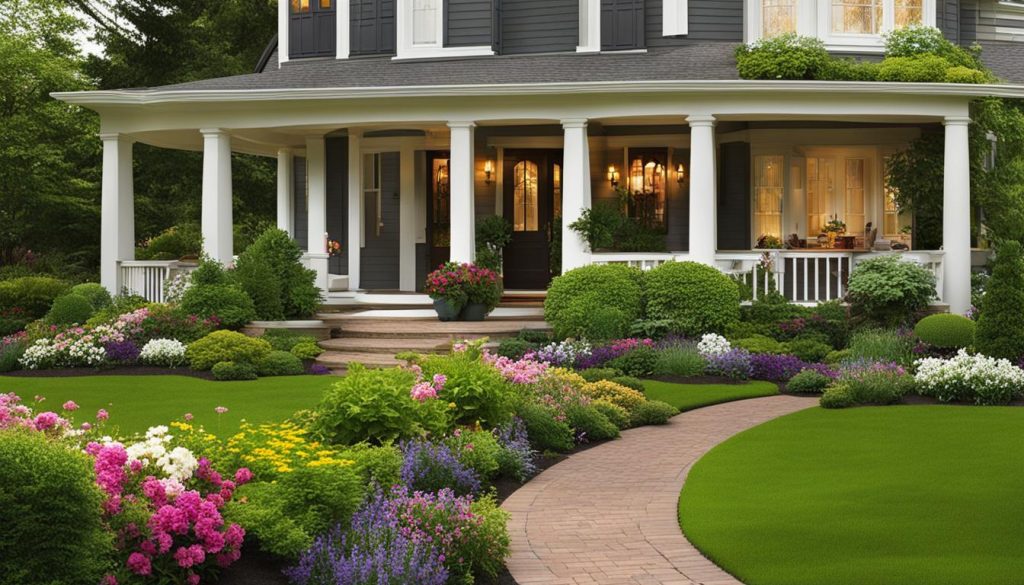Welcome to our article on front yard landscaping! At the heart of a beautiful home is a welcoming entrance, and with the right front yard landscaping, you can create just that. Your front yard is the first thing people see when they visit your home, and it sets the tone for what’s inside. Therefore, it’s essential to make a good first impression. In this section, we will explore why front yard landscaping is important in creating a welcoming entrance and how it can help elevate your home’s curb appeal. So, let’s dive in and learn how to make your front yard stand out!
Enhancing Curb Appeal with Front Yard Landscaping
Welcome back! Now that we understand the importance of a welcoming entrance, let’s dive into how front yard landscaping can enhance your home’s curb appeal.
Firstly, it’s important to note that a well-maintained and visually appealing front yard can instantly boost your home’s value. According to a recent study, homes with high curb appeal can sell for up to 7% more than similar homes with less attractive exteriors. So, it’s definitely worth investing some time and effort into your front yard landscaping!
One of the first things to consider when designing your front yard is the overall style and aesthetic you are aiming for. Do you want a modern, minimalist look or a more traditional, cozy vibe? Choosing a cohesive design will ensure that all elements of your landscaping work together to create a harmonious and visually appealing entrance.
Design Elements
The design elements you choose will play a significant role in enhancing your home’s curb appeal. Here are some essential design elements to consider:
- Flowerbeds and Garden Beds: Adding flowerbeds and garden beds to your front yard landscaping can add pops of color and visual interest. Consider adding plants that bloom at different times of the year to ensure a continuously vibrant display.
- Trees and Shrubs: Trees and shrubs can add height and depth to your front yard, creating a more dynamic landscape. Choose trees and shrubs that are native to your area and will thrive in your climate.
- Grass and Ground Cover: A lush green lawn can make your front yard look polished and well-maintained. If you live in an area with dry or water-restricted conditions, consider using ground cover plants or artificial turf to create a similar effect.
- Decorative Elements: Decorative elements such as statues, fountains, or birdbaths can add personality and visual interest to your front yard. However, be careful not to overdo it and choose elements that complement your overall design aesthetic.
Strategies
Here are some strategies you can employ to enhance your home’s curb appeal through front yard landscaping:
- Focus on Symmetry: Symmetry can create a sense of order and balance in your front yard, making it visually appealing. Consider placing identical flowerbeds or shrubs on either side of your front entrance.
- Introduce Color: Adding pops of color through flowers or decorative elements can make your front yard stand out. Consider using a limited color palette to create a cohesive look.
- Highlight Your Front Entrance: Your front entrance is the focal point of your home, so it’s important to highlight it in your landscaping. You can achieve this by placing potted plants on either side of your entrance or adding a pathway that leads directly to your front door.
By incorporating these design elements and strategies, you can elevate your curb appeal and create a welcoming entrance to your home. Stay tuned for our next section, where we’ll focus on the essential steps involved in planning and designing your front yard landscape.
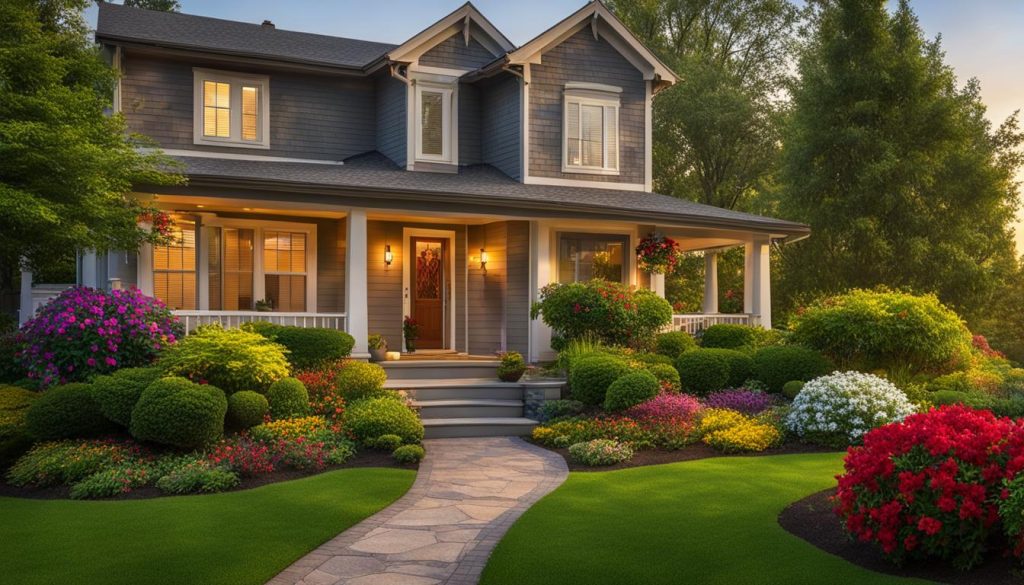
Planning and Designing Your Front Yard Landscape
Planning and designing your front yard landscape is the crucial first step towards creating the ultimate welcoming entrance. Before getting started, it’s important to assess your space and climate conditions to determine what type of plants and materials to use.
First, take a walk around your property and make a list of your must-haves. Do you need a pathway to the front door? A seating area? A water feature? A focal point, such as a sculpture or tree?
Next, consider the style of your home and how you can complement it with your front yard design. A modern home may benefit from clean lines and a minimalist approach, while a traditional home may look stunning with a more formal garden design.
Assess Your Climate
When planning your front yard landscape, it’s important to take into account your climate. Choose plants that are native to your area and that will thrive in your particular conditions. If you experience harsh winters, consider adding evergreens or hardscape elements that will provide structure and interest year-round.
Choose Your Plants Wisely
When selecting plants for your front yard, consider their growth habits, color, and texture. Mix and match different types of plants to create visual interest and depth. Choose a variety of plants that will bloom at different times of the year to keep your front yard looking beautiful no matter the season.
Pro-tip: Consider incorporating edible plants into your front yard landscape. Not only will they provide a source of food for your family, but they can also add an element of interest and color to your design.
Use the Right Materials
When it comes to materials, choose ones that will complement the overall style and color scheme of your home. Whether it’s natural stone for a traditional look or sleek metal for a modern touch, make sure the materials you choose are durable and suited for your climate conditions.
Pro-tip: Don’t forget to add mulch or rocks to your landscape design. Not only do these materials provide a neat and tidy look, but they also help to retain moisture in the soil and prevent weed growth.
By following these planning and designing tips, you’ll be on your way to creating a front yard landscape that is not only beautiful but also functional and welcoming. Remember to take your time and enjoy the process!
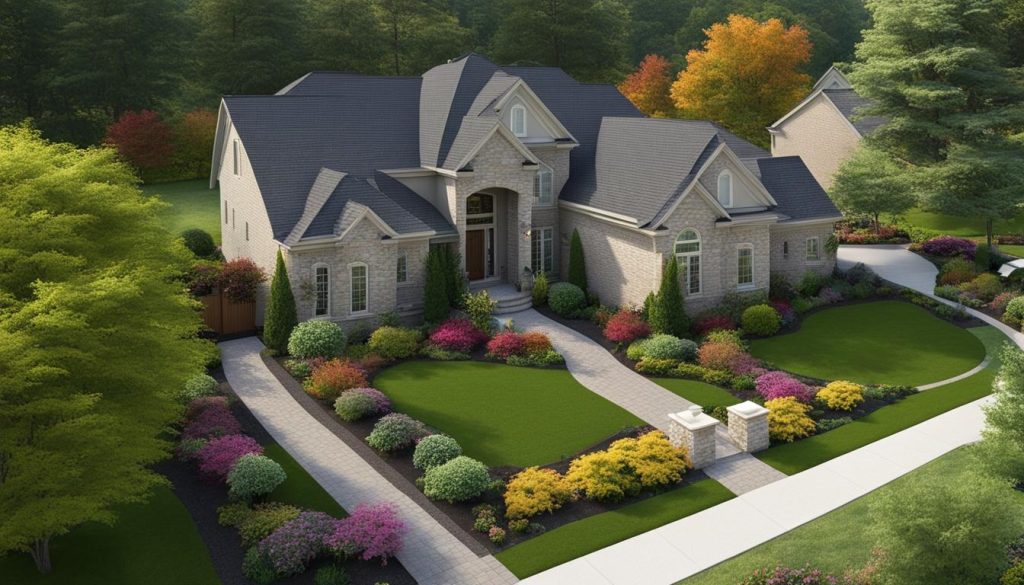
Creating Pathways and Walkways
Pathways and walkways are essential components of front yard landscaping. They are not only functional but also visually appealing and can lead visitors to your entrance. One of the essential factors to consider when creating pathways and walkways is the choice of materials. There are several options available, including brick, stone, gravel, concrete, and wood.
Brick and stone are popular choices for their durability and timeless aesthetic. They are suitable for different styles of homes, including traditional, colonial, and modern. Gravel can add a rustic charm to your entrance, while concrete is a practical and cost-effective solution that can be customized to different designs and textures. Wood is an eco-friendly option that can also add a warm and natural look to your pathway.
Placement Options
The placement of your pathway or walkway can significantly impact your entrance’s visual appeal. Straight pathways that lead directly to the entrance are the most common and practical option. However, you can also opt for curved or meandering paths that add some interest and a sense of discovery.
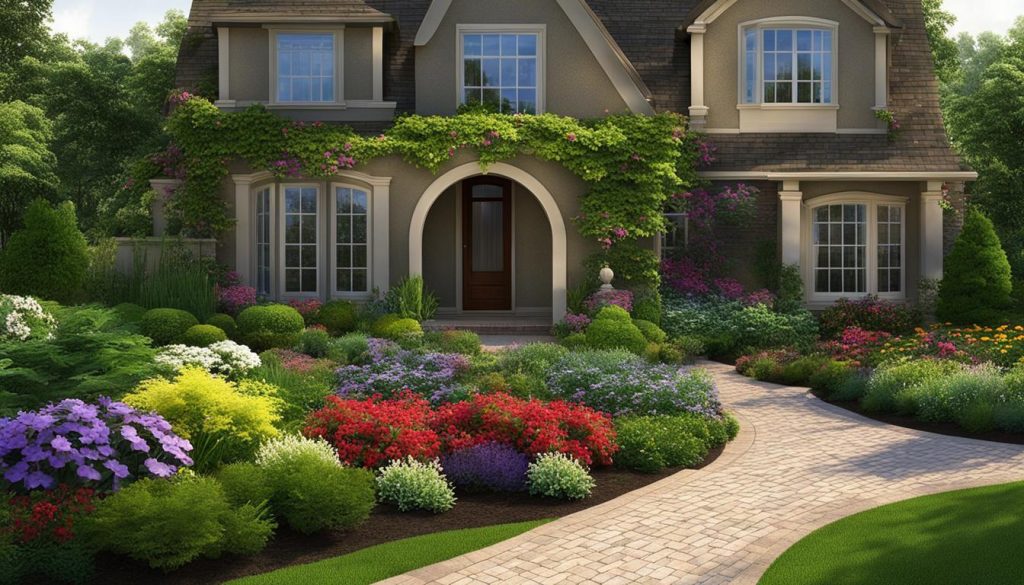
Tip: Consider the size of your front yard and the amount of foot traffic it receives when deciding on the pathway’s width. A wider path can provide more space for visitors and can accommodate strollers or wheelchairs.
Design Elements
Design elements can enhance the functionality and aesthetics of your pathway or walkway. Adding edging materials such as bricks, stones, or plants, can define the path’s borders and prevent soil erosion. Planting trees or shrubs along the walkway can add visual interest and shade.
Tip: If you have a long pathway, consider adding focal points such as benches, bird feeders, or garden statues, to break up the pathway’s monotony and provide visual interest.
- Choose materials that match your home’s style and landscape design.
- Consider the placement of your pathway or walkway to create a visually appealing entrance.
- Use design elements such as edging materials and planting to enhance the pathway’s aesthetics.
- Add focal points to break up long pathways and provide visual interest.
With these tips and ideas, you can create a beautiful and functional pathway or walkway that adds value and curb appeal to your home.
Adding Plants and Flowers to Your Front Yard
Nothing adds more charm and beauty to your front yard than planting colorful flowers and greenery. The right combination of plants can create a visually stunning entrance that reflects your personality and style.
When choosing plants for your front yard, consider the climate conditions and the amount of sunlight the area receives throughout the day. Some plants do well in direct sunlight, while others prefer shaded areas.
It’s also important to think about the color scheme you want to achieve. Do you want a riot of bold colors or a more subtle, coordinated palette? You can create a cohesive look by planting flowers in shades of the same color or by using complementary colors for an eye-catching contrast.
Best Plants and Flowers for Front Yard Landscaping
- Petunias: These vibrant flowers come in a variety of colors and bloom throughout the summer months. They are easy to maintain and grow well in most climates.
- Lavender: This aromatic herb adds a calming touch to your front yard and attracts pollinators like bees and butterflies.
- Hostas: These leafy plants are known for their variegated foliage and make an excellent ground cover. They grow well in shaded areas.
- Daffodils: These cheerful yellow flowers signal the arrival of spring and bloom early in the season. They are low-maintenance and multiply over time.
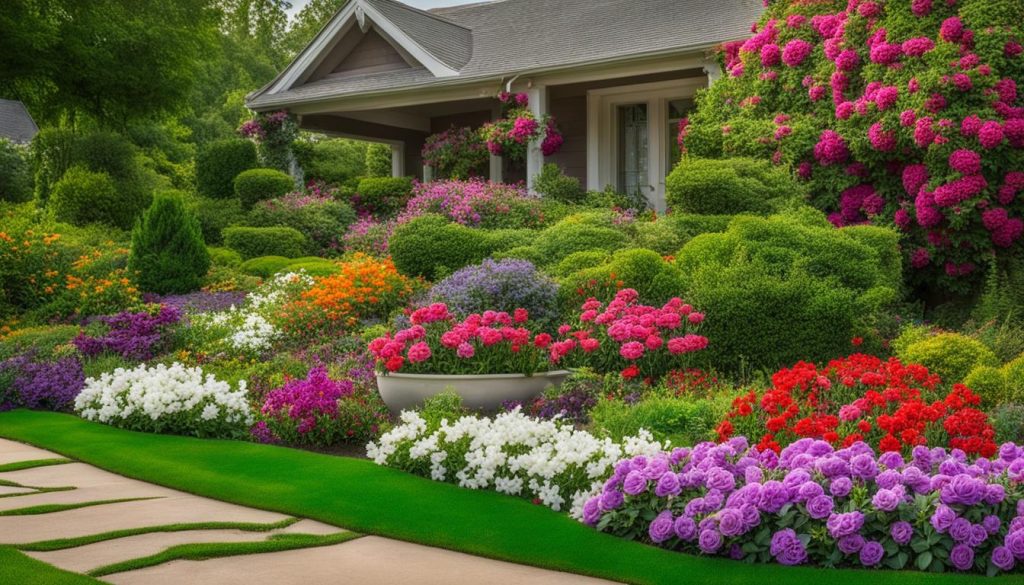
Integrating plants and flowers into your front yard design can also benefit local wildlife. Adding bird feeders and bird baths can attract feathered visitors to your garden.
Don’t forget to regularly water your plants and trim any dead or overgrown foliage to keep your front yard looking neat and well-maintained.
By incorporating plants and flowers into your front yard landscaping, you can create a welcoming and inviting entrance that adds value to your home and enhances its curb appeal.
Incorporating Lighting for a Welcoming Ambiance
When it comes to creating a welcoming ambiance in your front yard, lighting can make all the difference. Not only does it add an element of safety and security, but it can also highlight your home’s best features and create a warm and inviting atmosphere for guests.
Outdoor lighting fixtures come in various styles and types. Some popular options include:
- Wall sconces
- Post lights
- String lights
- Spotlights
- Pathway lights
Each type of lighting fixture serves a different purpose, and combining them can create a layered effect that adds depth and interest to your landscape at night.
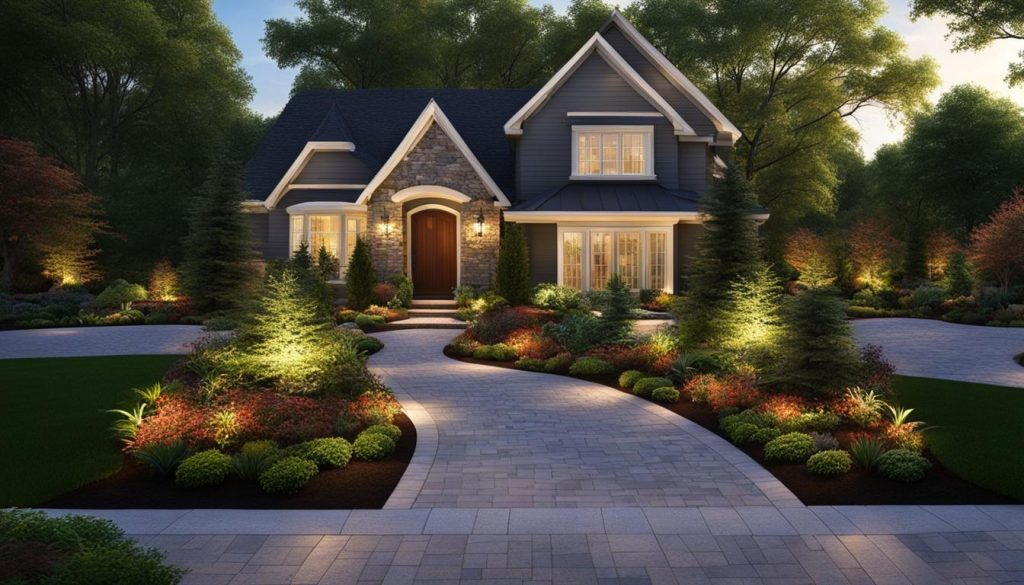
Placement of lighting fixtures is key to achieving a welcoming ambiance. Consider these tips:
- Place lights near the entrance to your home to enhance safety and visibility.
- Highlight your landscaping by placing spotlights or floodlights on trees, gardens, and other focal points.
- Use path lights to illuminate walkways and guide guests to your front door.
- Consider adding lighting to your porch or patio to create an inviting outdoor living space.
Remember that too much lighting can be overwhelming and can detract from the ambiance you’re trying to create. Stick to a few key fixtures and strategically placed lights for the best effect.
The Benefits of a Welcoming Ambiance
Creating a welcoming ambiance in your front yard not only adds beauty and value to your home, but it can also have positive psychological effects on both you and your guests. A well-lit and inviting entrance can reduce stress and anxiety, improve mood, and leave a lasting impression on visitors.
Take the time to plan your outdoor lighting design, and you’ll be rewarded with a front yard that is not only beautiful but also welcoming and inviting.
Adding Hardscape Elements and Focal Points
When it comes to front yard landscaping, adding hardscape elements and focal points can elevate your entrance to the next level. These features can add visual interest and personality to your front yard, improving its curb appeal and overall aesthetic.
There are several hardscaping options to choose from, such as patios, water features, sculptures, and retaining walls. When selecting hardscape elements, consider the size, style, and color scheme of your home. These elements should complement your home’s architecture and landscaping design.
Another way to enhance your front yard is by incorporating focal points. Focal points draw the eye and create a visual center for your front yard. These can be anything from a statement tree, a unique piece of art, or a dramatic water feature.
When choosing a focal point, consider the overall design of your front yard. A focal point should complement and enhance the rest of your landscaping, not overpower it.
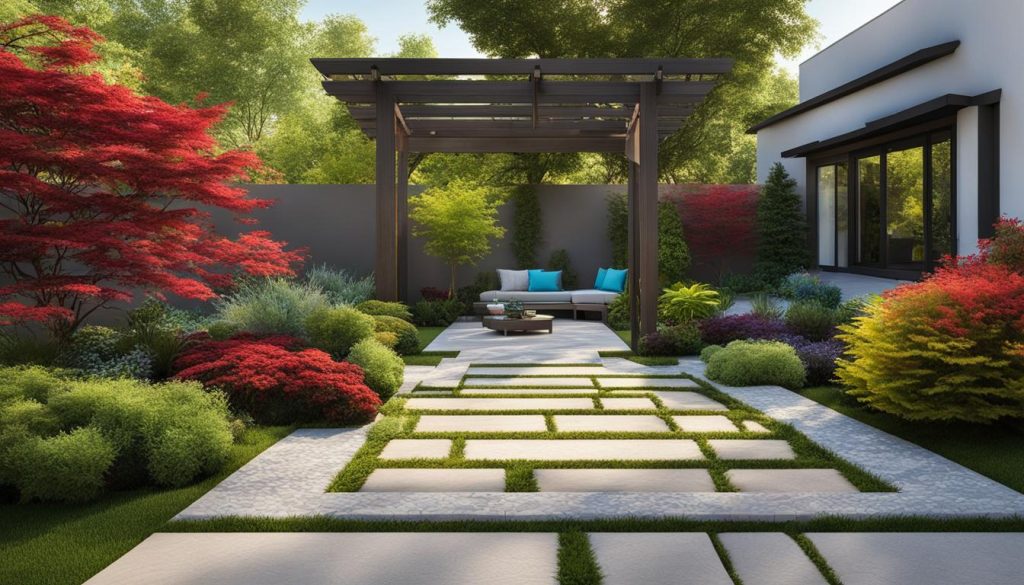
By incorporating hardscape elements and focal points, you can create a unique and inviting entrance to your home. Remember to choose elements that complement your home’s style and work harmoniously with the surrounding landscape.
Maintaining and Updating Your Front Yard Landscape
Having a beautiful and inviting front yard requires regular maintenance and occasional updates. Here are some tips and advice on how to keep your front yard landscape looking its best:
Regular Maintenance Tasks
Keeping your front yard landscape healthy and vibrant requires some regular maintenance tasks. These include:
- Watering plants and flowers as needed
- Pruning shrubs and trees to promote healthy growth
- Removing weeds and dead foliage
- Mowing and trimming the lawn to an appropriate length
By staying on top of these tasks, you can ensure your front yard remains visually appealing and welcoming.
Seasonal Adjustments
As the seasons change, so do the needs of your front yard landscape. Here are some tips on how to adjust your maintenance tasks accordingly:
- Fertilize plants and flowers in the spring to promote healthy growth
- Water more frequently during hot summers
- Rake leaves and prune shrubs in the fall
- Protect plants from frost and snow in the winter
By making seasonal adjustments, you can ensure your front yard landscape remains healthy and vibrant throughout the year.
Updating Your Front Yard Landscape
Occasionally, you may want to update your front yard landscape to keep up with changing trends or your own personal preferences. Here are some ways to update your front yard:
- Try out new plants and flowers to add variety and color
- Install new lighting fixtures to enhance ambiance and safety
- Add or replace hardscape elements, such as a new pathway or water feature
- Consider a new color scheme or design theme
By updating your front yard landscape, you can keep it looking fresh and modern while still maintaining its welcoming and inviting atmosphere.
By following these tips and making regular updates and adjustments, you can ensure that your front yard landscape remains a beautiful and inviting entrance to your home. At Landscape Designer, we have years of experience in landscaping services. If you have any questions, feel free to give us a call.
FAQ
What are some easy front yard landscaping ideas for creating a welcoming entrance?
Some easy front yard landscaping ideas for creating a welcoming entrance include planting colorful flowers, adding a pathway or walkway, and incorporating outdoor lighting for a warm ambiance.
How can front yard landscaping enhance curb appeal?
Front yard landscaping enhances curb appeal by creating an attractive and well-maintained entrance to your home. It includes elements like well-kept lawns, beautiful plants and flowers, and eye-catching hardscape features.
What should I consider when planning and designing my front yard landscape?
When planning and designing your front yard landscape, consider the size and shape of your space, the climate conditions in your area, and your personal preferences. Also, think about the maintenance requirements and the cohesive look you want to achieve.
How do pathways and walkways contribute to front yard landscaping?
Pathways and walkways contribute to front yard landscaping by providing a functional and visually appealing way to guide visitors to your entrance. They can be made from various materials such as stone, pavers, or gravel, and can be designed in different styles to complement your overall landscape design.
What are some tips for selecting the right plants and flowers for my front yard?
When selecting plants and flowers for your front yard, consider factors such as the amount of sunlight your yard receives, the soil conditions, and the climate in your area. Choose plants that will thrive in these conditions and create visual interest through a mix of colors, textures, and heights.
How can lighting be incorporated into front yard landscaping for a welcoming ambiance?
Lighting can be incorporated into front yard landscaping by adding fixtures along pathways, illuminating focal points, and installing ambient lighting near the entrance. This creates a warm and inviting atmosphere, enhances safety, and adds a touch of elegance to your front yard.
What are some hardscape elements and focal points I can add to my front yard?
Some hardscape elements and focal points you can add to your front yard include a patio or seating area, a water fountain or feature, sculptures or art installations, or even an eye-catching front door. These elements add visual interest and personality, making your entrance stand out.
How can I maintain and update my front yard landscape?
To maintain and update your front yard landscape, regularly mow the lawn, prune plants, and remove weeds. It’s also important to fertilize and water plants as needed. Additionally, consider making seasonal adjustments and periodically refreshing the design by adding new plants, changing out decorative elements, or updating lighting fixtures.

